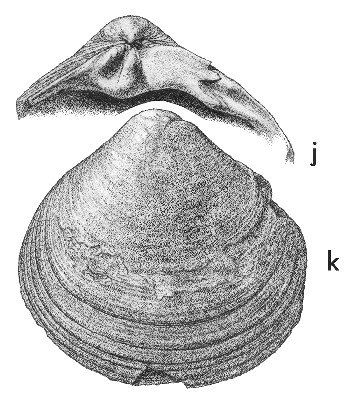
Revised descriptions of New Zealand Cenozoic Mollusca from Beu and Maxwell (1990)

 | Revised descriptions of New Zealand Cenozoic Mollusca from Beu and Maxwell (1990) | 
|
  (Pl. 1j): GS10195, I44/f8486, Boulder Hill; (Pl. 1k): GS1494, M46/f9500, Wangaloa, Wangaloan (GNS) |
Beu & Maxwell (1990): Chapter 5; p. 80; pl. 1 j, k
Synonymy: "Mactra crassa Hutton?" (not of Hutton, 1885)
Type species of Lahilleona Finlay & Marwick, 1937 (as a subgenus of Lahillia), now regarded as inseparable from Lahillia Cossmann, 1889 (Zinsmeister 1984, p. 1515)
Classification: Cardiidae: Lahilliinae
Description: Moderately large for superfamily (height 50-80 mm), rather thick-shelled dorsally, particularly in hinge region, but otherwise relatively thin-shelled; subequilateral with high, broad umbones. Posterior area not differentiated; lunule long, rather narrow; no escutcheon. Sculpture of growth lines and ridges only, but weak subsurface radial elements visible on some weathered shells. Hinge heavy, left valve with a prominent, high, triangular anterior cardinal and a feeble posterior cardinal tooth; right valve with a stout median cardinal and a subobsolete anterior cardinal. Both valves with a prominent posterior lateral tooth, but no anterior laterals. Nymph-plate very prominent, projecting above posterodorsal margin and separated from it by a deep ligamental groove. Adductor muscle scars moderately large, impressed dorsally. Pallial sinus shallow, rounded. Inner margins smooth.
Comparison: Specimens of Lahillia from certain Late Cretaceous localities (i.e. Middle Waipara; Haumuri Bluff; Shag Point) were identified by Finlay & Marwick (1937, pp. 32-33) as L. aff. neozelanica. If these should prove to be conspecific with the Paleocene species, L. neozelanica would be the only bivalve known to have survived from Late Cretaceous into the early Cenozoic in New Zealand.
Lahillia is of considerable biogeographical interest, as it is known only from southern South America (Late Cretaceous-Late Miocene), Seymour Island (Late Cretaceous-Late Eocene), New Zealand (Late Cretaceous-Early Paleocene) and Australia (Middle Paleocene) (Zinsmeister 1982, text fig. 6). It is one of the most characteristic faunal elements in the Weddellian Province, proposed by Zinsmeister (1979) for Late Cretaceous-early Paleogene shallow-water marine assemblages in eastern Gondwana.
Distribution: Wangaloan, Wangaloa Formation, Wangaloa (type); Boulder Hill (rather uncommon but conspicuous at both localities).
Cite this publication as: "A.G. Beu and J.I. Raine (2009). Revised
descriptions of New Zealand Cenozoic Mollusca from Beu and Maxwell (1990). GNS
Science miscellaneous series no. 27."
© GNS Science, 2009
ISBN
978-0-478-19705-1
ISSN 1177-2441
(Included with a PDF facsimile file
copy of New Zealand Geological Survey Paleontological Bulletin 58 in CD version
from: Publications Officer, GNS Science, P.O. Box 30368 Lower Hutt, New
Zealand)